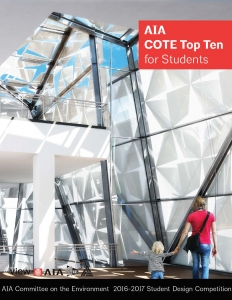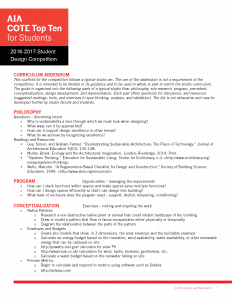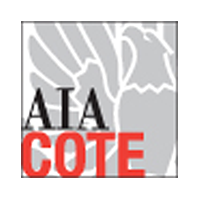Competition Overview
As today’s architecture students move into the profession, they will inherit a rapidly changing world, both in terms of the physical contexts of their work, and the tools, materials and processes available to create it. Preparing students for this challenging, dynamic future calls for greater integration of innovative ecological design thinking within the design discourse of universities across the country.
About the Competition
The American Institute of Architects Committee on the Environment (AIA COTE), in partnership with the Association of Collegiate Schools of Architecture (ACSA), is pleased to announce the third annual AIA COTE Top Ten for Students. The program challenges students, working individually or in teams, to submit projects that use a thoroughly integrated approach to architecture, natural systems, and technology to provide architectural solutions that protect and enhance the environment. The competition will recognize ten exceptional studio projects that seamlessly integrate innovative, regenerative strategies within their broader design concepts.
Jurors
Jessica Nutz, University of North Carolina at Charlotte
John Quale, University of New Mexico
Holly Samuelson; Harvard University
Lisa Matthiessen, U.S. Green Building Council
Greg Mella, SmithgroupJJR
Criteria for Judging
Entries will be judged on their success in addressing all ten sustainability measures. Successful responses will demonstrate creative and innovative integration of daylighting, materials, water, energy, and ecological systems, through a cohesive and beautiful architectural understanding. Entries are examined in regard to their design and innovation, integration with their community, land use and effect on site ecology, bioclimatic design, energy and water use, approach to light and air, materials and construction, long-life considerations, and feedback loops. Entries will also be judged for the success with which the project has met its individual requirements, with particular emphasis on design excellence.
The project submission will include for each of the measures a demonstration through narrative, illustration, and in some cases an approach and diagram or metric for the emphasis and intent of the design decisions. These measures are intended to foster leadership (and ability) among designers in all facets of environmental decision-making; and to demonstrate design quality and ways to seamlessly integrate innovative, regenerative strategies within their broader design concepts.
Program
Building Program + Site
Students are invited to submit their studio projects. Entries must be buildings, but can be of any program, at any scale, in any environmentally responsible location. Projects can be a remodel or adaptive re-use. Work should have been completed in a design studio or related class from January 2016 – present.
Ten Sustainability Measures
Measure 1: DESIGN & INNOVATION
Sustainable design is an inherent aspect of design excellence. Projects should express sustainable design concepts and intentions, and take advantage of innovative programming opportunities.
Narrative: Describe how sustainability strategies are incorporated into the overall design strategy. What are the major environmental issues and goals?
May include:
• Key environmental issues; how and why they became important priorities
• Key ecological goals and concepts for your project and how they shaped your thinking.
• How these goals and concepts were expressed in the design
• Sustainable design innovations
• How sustainability measures led to a better overall project design
• Process of program analysis; resource efficiencies realized by innovative programming
• Efforts to “right size” the project and to reduce unnecessary square footage.
Graphic: Diagram showing major design / sustainability concepts
Measure 2: REGIONAL/COMMUNITY DESIGN
Sustainable design values the unique cultural and natural character of a given region.
Narrative: How does the design respond to the region where it’s located? How does the design promote regional and community connectivity? What steps are taken to encourage alternative transportation?
May include:
• How the design relates to the local context and to larger regional issues
• How the design promotes regional and community connectivity
• How the design promotes a sense of place, public space and community interaction
• How the design educates its users about the environmental strategies it employs
• Efforts to provide for those using transportation alternatives
• Site selection criteria to reduce automobile use
• How mandated parking was reduced
Graphic: Open
Metric: Walk score: (from Walkscore.com)
Measure 3: LAND USE & SITE ECOLOGY
Sustainable design protects and benefits ecosystems, watersheds, and wildlife habitat in the presence of human development.
Narrative: How does the development of the site respond to its ecological context? Consider water, air, plants, and animals at different scales.
May include:
• How the development of the site responds to its ecological context, including the watershed, and air and water quality at different scales from local to regional level
• How the development of the site and buildings contribute to environmental quality
• How the design accommodates wildlife habitat preservation and creation
• How the design protects or creates on-site ecosystems
• How the design responds to local development density or conditions
• How the design encourages local food networks
Graphic: Native Landscape Profile (flora, fauna)
Measure 4: BIOCLIMATIC DESIGN
Sustainable design conserves resources and maximizes comfort through design adaptations to site-specific and regional climate conditions.
Narrative: Describe how the building reacts to the local climate and site with an emphasis on occupant comfort. Discuss how the building massing and fenestration relates to the sun path and the prevailing winds.
May include:
• Project response to local climate, sun path, prevailing breezes, soil, hydrology, and seasonal and daily cycles through passive design strategies
• Description of internal versus external building loads
• Design strategies that reduce/eliminate the need for non-renewable energy resources
• How these strategies specifically shaped the plan, section, and massing
• How these strategies specifically affected project placement, orientation, and shading
• Integrated pest management considerations
Graphic: Psychrometric or bioclimatic chart profile of local climate that illustrates bioclimatic design strategies; Building section, or other appropriate diagram that demonstrates bioclimatic strategies
Metric: Percent of the year that occupants will be comfortable using passive systems
Measure 5: LIGHT & AIR
Sustainable design creates comfortable interior environments that provide daylight, views, and fresh air.
Narrative: Discuss design strategies that relate to daylighting, electric lighting, ventilation, indoor air quality, views, and individual controllability.
May include:
• Design strategies for daylighting, task lighting, and views
• Design strategies for ventilation, indoor air quality, and personal control systems
• How the project’s design enhances users’ connectedness to nature
• Design team approach to integration of natural systems and appropriate technology
Graphic: Model photos, drawings or diagrams of daylight and ventilation strategies; test models.
Metric: Percent of the building that can be daylit (only) during occupied hours; Percent of floor area with views to the outdoors; Percent of floor area within 15 ft. of an operable window.
Measure 6: WATER CYCLE
Sustainable design conserves water and protects and improves water quality.
Narrative: How does the design manage storm water? How does the design conserve potable water? How is the project innovative in the way that it uses and treats water?
May include:
• How building and site design strategies manage site water and drainage
• Design strategies that capitalize on renewable water sources (i.e. precipitation) on site
• Water-conserving landscape and building design strategies
• Reuse strategies for water including use of rainwater, graywater, and wastewater
Graphic: Open
Metric: Percent of storm water that is managed onsite: (2 year, 24-hour event. Use supplied spreadsheet to calculate)
Measure 7: ENERGY FLOWS & ENERGY FUTURE
Sustainable design conserves energy and resources and reduces the carbon footprint while improving building performance and comfort. Sustainable design anticipates future energy sources and needs.
Narrative: How does the design seek to decrease the total energy use and carbon footprint of the building? Emphasize strategies to reduce heating and cooling loads, reduce peak electricity demand, reduce plug loads, generate onsite energy, and anticipate future carbon free energy sources.
May include:
• How the design reduces energy loads for heating, cooling, lighting, and water heating
• How the design and integration of building systems contributes to energy conservation and reduced use of fossil fuels, reduces green house gas emissions and other pollution improves building performance and comfort.
• Use of on-site renewable and alternative energy systems.
• Anticipation of future and carbon neutral fuel sources
• Strategies to reduce peak electrical demand.
• How the design remains functional during power outages or interruptions in fuel supply
Graphic: Open
Metric: Total EUI: (build a simple energy model to calculate EUI using eQuest, Sefeira, Autodesk® Green Building Studio, or another energy modeling program); Energy generation (if any) in kWh/yr: (use PVWatts® Calculator or solar-estimate.org for solar or wind); Net EUI (with renewables if applicable)
Measure 8: MATERIALS & CONSTRUCTION
Sustainable design includes the informed selection of materials and products to reduce product-cycle environmental impacts, improve performance, and optimize occupant health and comfort.
Narrative: Describe the project’s material selection criteria, considerations and constraints. What efforts were made to reduce the amount of material waste and the environmental impact of materials over their lifetime? Discuss specific materials used.
May include:
• Efforts to reduce the amount of material used on the project.
• Materials selection criteria, considerations, and constraints for: optimizing health, durability, maintenance, and energy use reducing the impacts of extraction, manufacturing, and transportation
• Enclosure performance in relation to air, moisture, water and thermal characteristics
• Consideration of life cycle impacts and results of life cycle assessment if available
• Construction waste reduction plans; strategies to promote recycling during occupancy
Graphic: Wall section of the building envelope design and either a hygro-thermal analysis or life cycle assessment.
Measure 9: LONG LIFE , LOOSE FIT
Sustainable design seeks to enhance and increase ecological, social, and economic values over time.
Narrative: Describe how the design promotes long-term flexibility, adaptability, and resilience.
May include:
• How the project was designed to promote long-term flexibility and adaptability
• Anticipated project service life; description of components designed for disassembly
• Materials, systems, and design solutions developed to enhance versatility, durability, and adaptive reuse potential
• How the project anticipates and celebrates weathering over time
Graphic: Open
Measure 10: COLLECTIVE WISDOM & FEEDBACK LOOPS
Sustainable design strategies and best practices evolve over time through documented performance and shared knowledge of lessons learned.
Narrative: What steps would you take to ensure that the building performs the way that it is designed? What lessons have you learned from this project that you will apply to the next project? What lessons have you learned from past projects that were applied to this project?
May include:
• Modeling and evaluation of the design during the programming and design phases
• Collaborative efforts between design team, consultants, client, and community
• Lessons learned during the design of the building
• How these lessons would change your approach to this project or future projects
• A question that would be investigated in a post-occupancy evaluation of this project.
Graphic: Open
Registration & Submissions
Eligibility
The competition is open to students from ACSA Member Schools from the U.S., Canada and Mexico. The competition is open to upper level students (third year or above, including graduate students). Students are required to work under the direction of a faculty sponsor. Submissions will be accepted for individual as well as team projects. Teams must be limited to a maximum of five students.
Students are invited to submit their studio projects. Entries must be buildings, but can be of any program, at any scale, in any environmentally responsible location. Projects can be a remodel or adaptive re-use.
Work should have been completed in a design studio or related class from January 2016 – present.
Registration
A faculty sponsor is required to enroll students by completing this registration form by December 7, 2016. Complete a form for your entire studio or for each individual student or team of students participating. Students or teams wishing to enter the competition on their own must have a faculty sponsor, who should complete the form. There is no entry or submission fee to participate in the competition. Please add the email address competitions@acsa-arch.org to your address book to ensure that you receive all emails regarding your participation in the competition.
During registration, the faculty will have the ability to add students, create teams, assign students to teams, and add additional faculty sponsors. Registration is required by December 7, 2016, but changes are allowed up until the student(s) upload a final submission.
CAN’T FIND YOUR USERNAME OR PASSWORD?
Please use the Forgot Password tool -or- contact the ACSA office directly to reset your credentials.
Faculty Responsibility
The administration of the competition at each institution is left to the discretion of the faculty within the guidelines set forth in this document. Work should have been completed in a design studio or related class within the 2015-2016 or 2016-2017 academic year. Design work completed before 2015 will not be accepted.
Each faculty sponsor may develop an internal system to evaluate the students’ work using the criteria set forth in this Competition Program and the Curriculum Addendum. The evaluation process should be an integral part of the design process, encouraging students to scrutinize their work in a manner similar to that of the jury. The final result of the design process will be a submission of four presentation boards and a narrative describing the design solution and approach to the each of the ten sustainability measures.
Submission Requirements
The submission will focus on how the project addresses ten sustainability measures through graphics and written narratives/abstract. You will submit the following materials online:
- No more than four (4) digital boards at 20” x 20” (PDF or JPEG files). Boards should address the following:
- Graphics: For each sustainability measure, provide one drawing, rendering, diagram, image and/or graphic that best displays how the project addresses the measure. Some measures ask for a specific diagram, and others are open ended. Following are primary drawings for basic project understanding:
- Energy Performance Diagrams, Details & systems
- Three-dimensional representation, either in the form of digital renderings; axonometric; perspective; or model photographs – to illustrate the character of the project.
- Building/Site sections sufficient to show site context and major program elements
- Site plan showing the surrounding buildings, topography, and circulation patterns
- Floor plans
- Graphics: For each sustainability measure, provide one drawing, rendering, diagram, image and/or graphic that best displays how the project addresses the measure. Some measures ask for a specific diagram, and others are open ended. Following are primary drawings for basic project understanding:
- Metric: Some sustainability measures ask for a specific calculated metric. Provide a brief description of your approach to obtain that metric (basis, method, program used, and assumptions), when applicable.
- Abstract: (200 words maximum for each sustainability measure for a total of 2,000 word maximum). The narratives should answer the questions posed in the ten measures. The specific questions for each measure are meant to be a guide; each one does not need to be answered.
*During submission, simply copy/paste this text into the “Abstract” text field.
- Program Brief: Your project/concept statement (approach, program, intentions, strategies) also describe the building type, lists all programmatic spaces, gross square footage and project location (setting and context) (200 words maximum)
*During submission, simply copy/paste this text into the “Program” text field.
Incomplete or undocumented entries will be disqualified. All drawings should be presented at a scale appropriate to the design solution and include a graphic scale and north arrow.
Project authorship must remain anonymous. The names of student participants, their schools, or faculty sponsors, must NOT appear on the boards, narrative/abstract or project title. If authorship is revealed on any submission materials the entry will be disqualified.
Online Project Submission
All boards are required to be uploaded through the ACSA website in Portable Document Format (PDF) or image (JPEG) files. Participants should keep in mind that, due to the large number of entries, preliminary review does not allow for the hanging end-to-end display of presentation boards. Accordingly, participants should not use text or graphics that cross over from board to board.
Project authorship must remain anonymous. The names of student participants, their schools, or faculty sponsors, must NOT appear on the boards, narrative/abstract or project title. If authorship is revealed on any submission materials the entry will be disqualified.
Students are required to upload final submissions through the ACSA Competition website at www.acsa-arch.org by 5:00 pm Eastern Time, on January 18, 2017. If the Submission is from a team of students all student team members will have the ability to upload the digital files. Once the final submit button is pressed no additional edits, uploads, or changes can be made. Once the final Submission is uploaded and submitted each student will receive a confirmation email notification. You may “save” your submission and return to complete. Please note: the submission is not complete until the “complete this submission” button has been pressed. For team projects: each member of team projects may submit the final project.
Winning projects will be required to submit high-resolution original files/images for use in competition publications and exhibit materials.
Submission Instructions
Upon registration, each competition registrant should have received two automatic emails: 1) confirmation of your registration; 2) personal ACSA credentials to log into the ACSA website. When you are ready, follow these steps to submit your final project:
- Log into the ACSA website with your personal ACSA credentials
- Click “My ACSA.”
- Click “My Competitions.”
- Confirm you are uploading to the correct competition/category
- Click “Upload Submission.”
- From here you will have a series of tabs to copy/past your abstract + program brief and upload 4 digital boards (20” x 20″ PDF or JPEG files).
- Once your final project has been completely uploaded and confirmed, click “Complete this Submission.
* You may “Save” your submission and return to complete. Please Note: the submission is not complete until the “Complete This Submission” button is pressed.
* All participants, including the faculty sponsor, will receive a submission confirmation email.
*Reminder: the names of participants, their schools, or faculty sponsors, must NOT appear on any of the submitted material. For the complete submission guidelines, click here.
Awards + Recognition
$5,000
in cash prizes
Resources, References, & Tools
An intention of all ACSA competitions is to make students aware that research is a fundamental element of any design solution. Students are encouraged to research the various measures of sustainability as well as precedent projects from professional practice. These tools and resources will get you started, however you may use whatever tools and resources are available to you.
1. AIA COTE Top Ten for Students: Curriculum Addendum
2. SPREADSHEET – Percent of storm water that is managed onsite
3. AIA COTE website: aia.org/cote
4. AIA COTE Top Ten for Professionals Projects: http://www.aiatopten.org/taxonomy/term/9
5. Architecture2030 organization and 2030 Palette: Architecture2030.org
6. ARCHIVE online exhibition of faculty and student projects and stories: Archive100.org
7. DeKay, Mark and G.Z. Brown. Sun, wind & light: architectural design strategies. 3rd ed. Hoboken: John Wiley & Sons, 2014. Print.
8.Kwok, Alison, and Walter Grondzik. The Green Studio Handbook, 2nd ed. London: Routledge, 2011. Print.
9. Muller, Brook. Ecology and the Architectural Imagination. London: Routledge, 2014. Print.
10. Wells, Malcolm. “A Regeneration-Based Checklist for Design and Construction,” Society of Building Science Educators, 1999. http://www.sbse.org/resources/
11. Climate Consultant: http://www.energy-design-tools.aud.ucla.edu/climate-consultant/request-climate-consultant.php
12. PVWatts Calculator: http://pvwatts.nrel.gov/
13. Hawken, Paul, Amory B. Lovins, and L. Hunter Lovins. “Tunneling Through the Cost Barrier.” Natural capitalism: creating the next industrial revolution. Snowmass, CO: Rocky Mountain Institute, 2008. Available at: http://www.natcap.org/images/other/NCchapter6.pdf
Downloads
Eric Wayne Ellis
Senior Director of Operations and Programs
eellis@acsa-arch.org
202.785.2324
Allison Smith
Programs Manager
asmith@acsa-arch.org
202.785.2324

 Study Architecture
Study Architecture  ProPEL
ProPEL 




